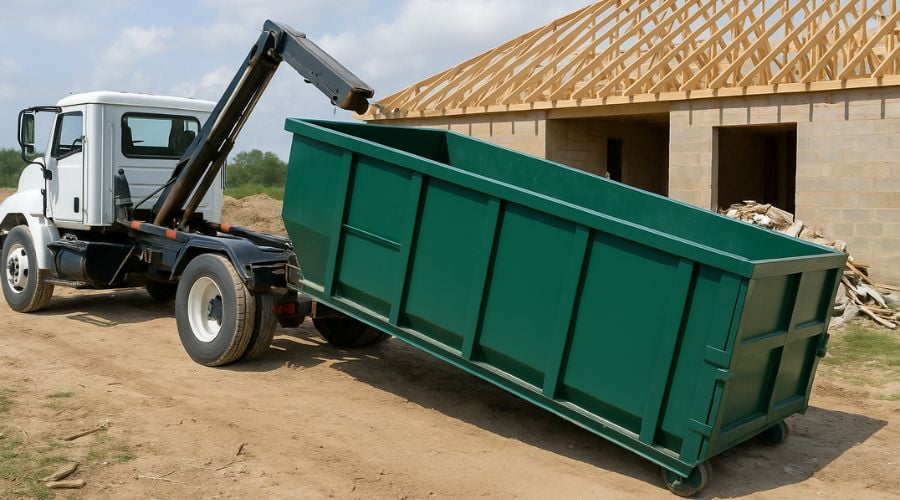Thinking about renting a dumpster, and you’re now realizing they come in different sizes for different uses, and now you’re wondering which is right for you? Don’t worry, we’ve got you covered! In this guide, we’ll cover everything you need to know about roll-off dumpster sizes, so you can make the right decision for your needs.
Key Takeaways: Roll Off Dumpster Sizes
-
Dumpster sizes are measured in cubic yards. One cubic yard is roughly the size of a standard washing machine.
-
The most common roll-off sizes are 10, 15, 20, 30, and 40 yards, each suited for different types of projects and debris.
-
Choosing the right size upfront saves money and hassle, helping you avoid overage fees or needing an extra haul.
What is a Roll Off Dumpster?
If you’re looking into roll off dumpster sizes, chances are you already have a general idea of what they are and how they can benefit you. But just to be sure, let’s provide you with a general overview so we’re all on the same page.
A roll off dumpster is designed for projects that generate a lot of waste, more than what your regular trash bins can handle. Think home renovations, cleanouts, roofing jobs, or landscaping overhauls. What makes them unique is that they come in different size options to fit different project needs, and they’re delivered and picked up by a truck that literally rolls the dumpster off at your site.
That part’s straightforward. Where things start to get confusing is figuring out what size dumpster you actually need, and that’s what the rest of this guide is here to help you with.
Related: Roll Off Dumpster Rental Guide
Roll Off Dumpster Sizes
Now that we’ve covered the basics, let’s talk about what you really came here for: roll off dumpster sizes.
You’ve probably noticed that dumpster sizes are listed with the word “yard” attached to them (and if not, well, this is us telling you they are). That’s because roll-off dumpsters are measured in cubic yards, which is a measure of volume. One cubic yard is about the size of a standard washing machine. So when you see a 10-yard dumpster, think: “Can hold about 10 washing machines’ worth of waste.
This specific measurement is also why you’ll often see dumpster sizes explained in terms of how many pickup truck loads they can hold. It’s just another way to help you picture the actual capacity, because let’s be honest, most of us don’t think in cubic yards.
Now that you’ve got a handle on how sizing works, let’s look at the actual options.
Roll off dumpsters come in various sizes, so there isn’t a one-size-fits-all choice. However, depending on your project, how much debris you’ll have, and how heavy it is, you can better determine which suits your needs.
Below, we’ll break down the most common roll of dumpster sizes, what they’re typically used for, and who rents them. Followed by a helpful roll-off dumpster sizes comparison chart! This way, you can figure out which one actually fits your project needs without guessing.
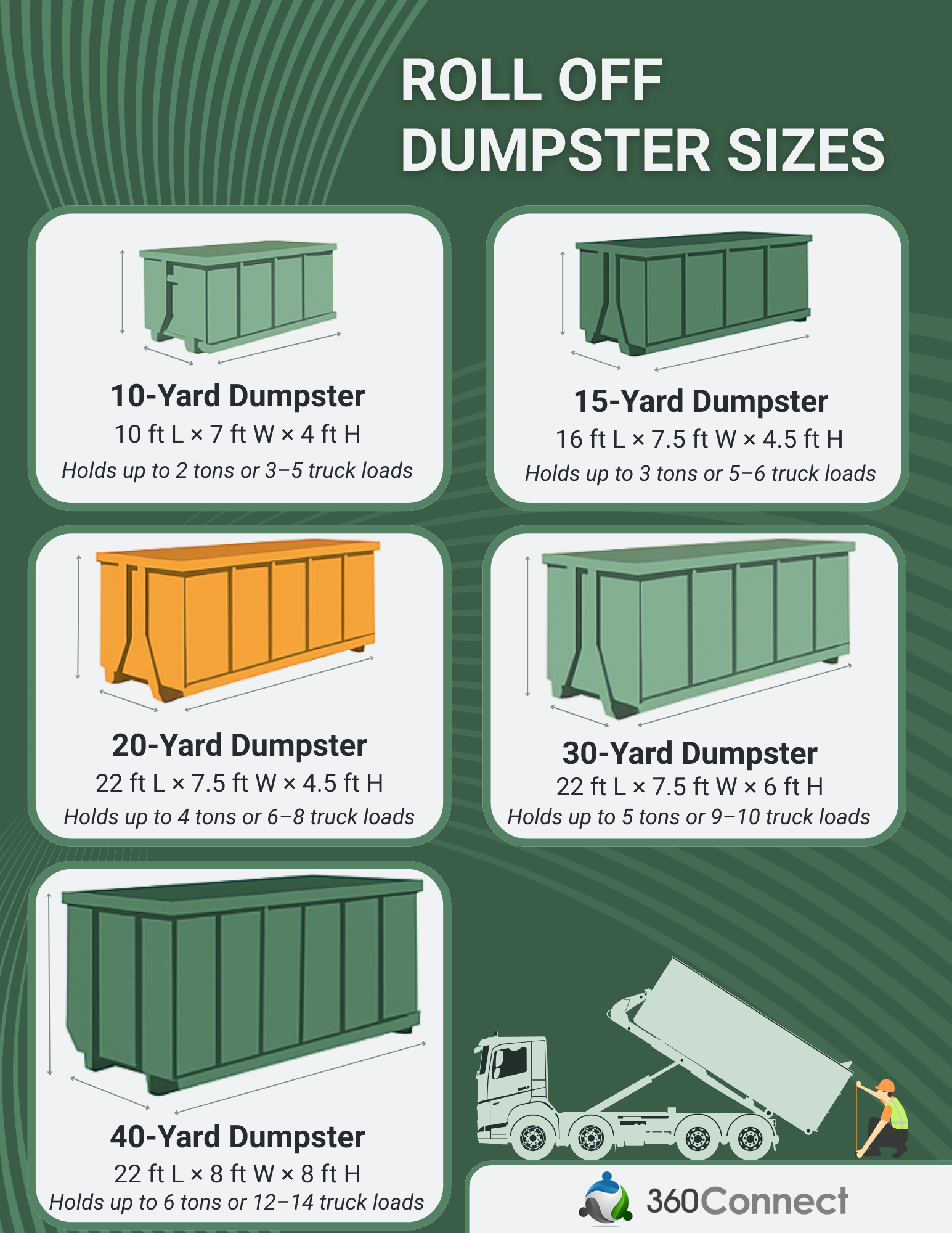
Common Roll Off Dumpster Sizes
10-Yard Dumpster
Dimensions: 10 ft. long × 7 ft. wide × 4 ft. high
Capacity: Holds about 3-5 pickup truck loads
Weight Limit: 1-2 tons

Please note: The exact dimensions, capacity, and weight limit can vary depending on the dumpster rental company.
The 10-yard dumpster is one of the smallest options, but that doesn’t mean it’s only for tiny jobs. In fact, it’s one of the most common roll off dumpster sizes for homeowners taking on quick, manageable projects that still generate more waste than your curbside bin can handle.
This size is a solid choice for things like small remodeling projects, garage or attic cleanouts, light landscaping jobs, or clearing out a few bulky items before a move. It’s compact enough to fit in most driveways without taking over your entire space, which makes it a go-to for tight residential areas or HOAs with restrictions.
It’s also ideal when you’re dealing with lighter debris like wood, drywall, cardboard, yard waste, or general household junk. Just keep in mind: if your materials are dense or heavy, like concrete or dirt, you might hit the weight limit quickly, even if there’s still room left in the container.
Common Uses of 10-Yard Dumpster
- Cleaning out a small garage, attic, or shed
- Replacing flooring in a single room
- Light landscaping or yard maintenance
- Small kitchen or bathroom updates
Best for:
Homeowners, renters, or contractors working on quick-turn projects that need just enough space to get the job done, without overcommitting.
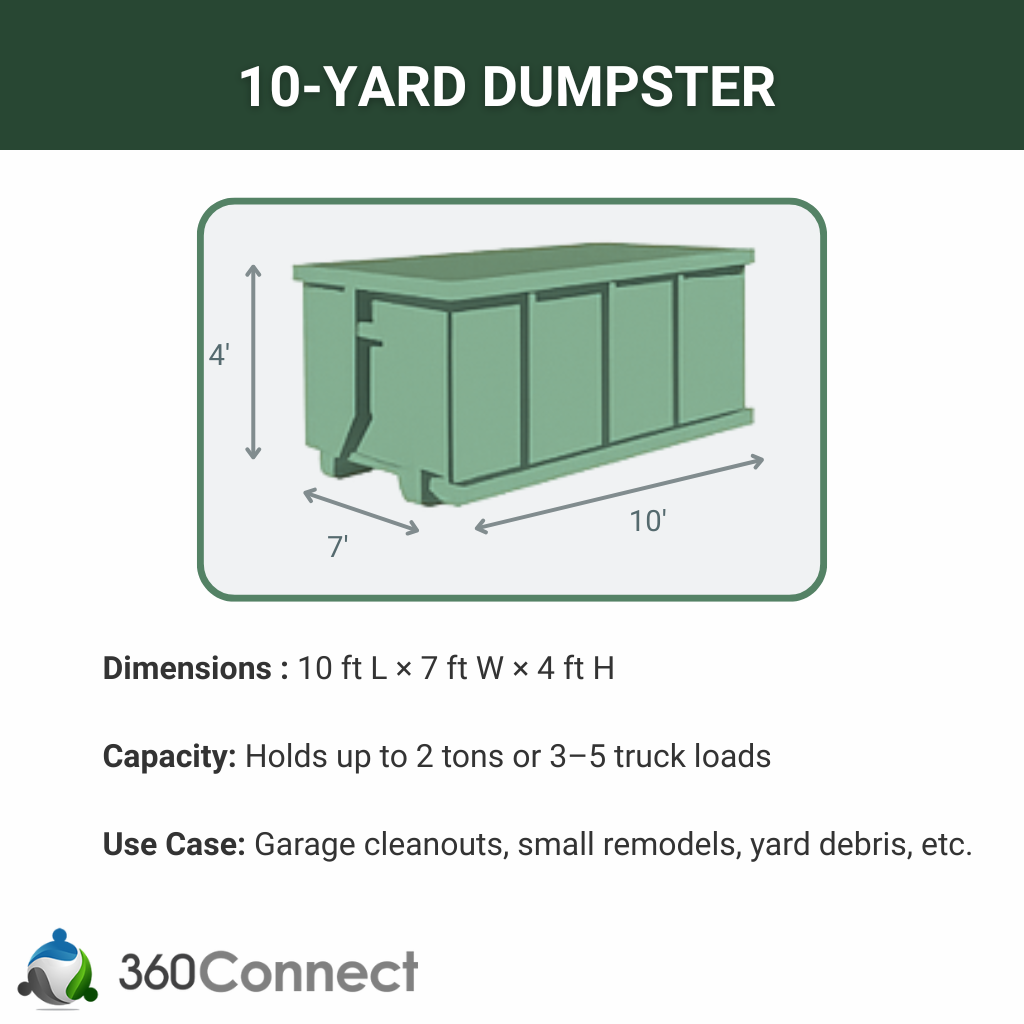
15-Yard Dumpster
Dimensions: 16 ft. long × 7 ft. wide × 4.5 ft. high
Capacity: Holds about 5–6 pickup truck loads
Weight Limit: 2–3 tons
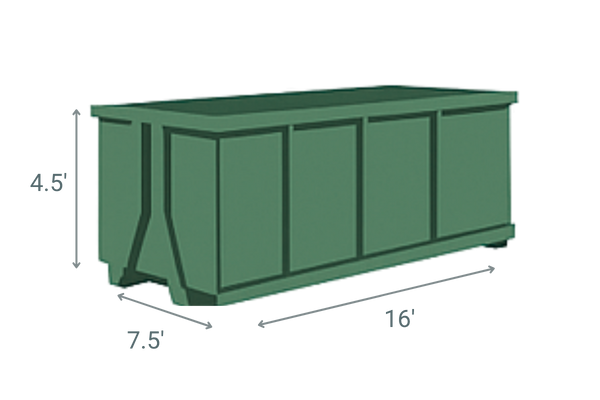
Please note: The exact dimensions, capacity, and weight limit can vary depending on the dumpster rental company.
The 15-yard dumpster is a great middle ground between small and mid-sized projects. It gives you a little more room than a 10-yard without the larger footprint of a 20-yard, making it a popular choice for residential jobs that fall somewhere in between.
It’s ideal for slightly larger home projects like ripping out old carpet, replacing siding, removing a deck, or clearing out multiple rooms. You’ll often see it used by homeowners doing renovations or contractors working on smaller remodeling jobs.
This size can still fit comfortably in most driveways, which makes it great for urban or HOA-restricted areas. It handles light-to-moderate materials well, but like with any dumpster, heavy debris like concrete should be discussed with your rental provider in advance.
Common Uses of 15-Yard Dumpster
- Multi-room cleanouts
- Carpet and flooring removal
- Small deck demolition
- Minor renovation projects
Best for:
Homeowners or contractors who need a bit more space than a 10-yard dumpster offers but want to avoid going overboard with size or cost.
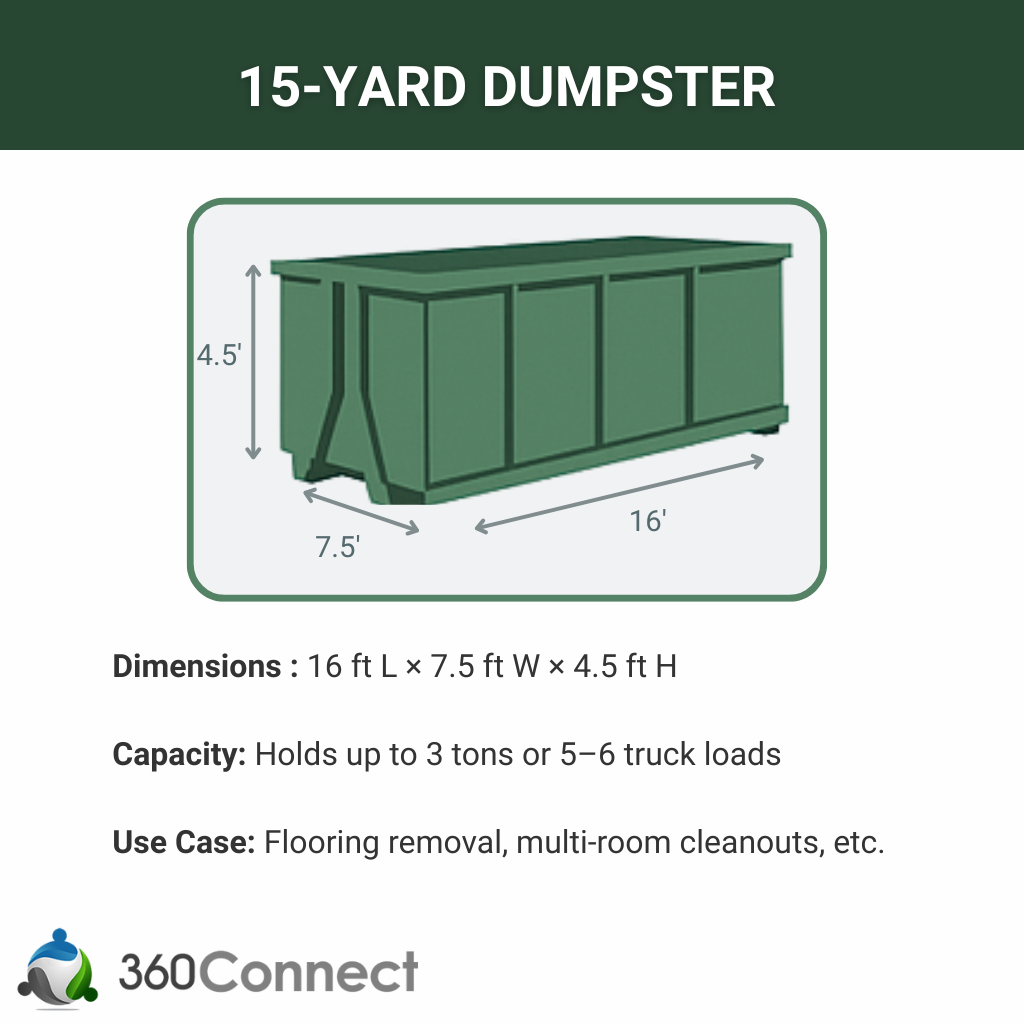
20-Yard Dumpster
Dimensions: 22 ft. long × 7.5 ft. wide × 4.5 ft. high
Capacity: Holds about 6–8 pickup truck loads
Weight Limit: 2–4 tons
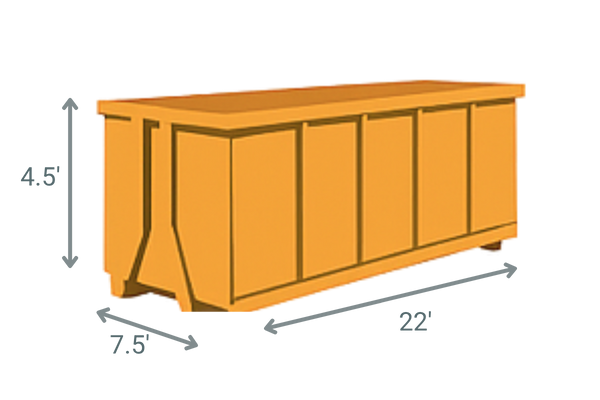
Please note: The exact dimensions, capacity, and weight limit can vary depending on the dumpster rental company.
The 20-yard dumpster is one of the most popular roll off dumpster sizes, and for good reason. It offers a generous amount of space without being difficult to place, making it ideal for both residential and light commercial job sites.
It’s a go-to for kitchen or bathroom remodels, roof replacements, large landscaping projects, or any job generating bulky debris. Contractors also use this size on smaller construction or renovation sites, thanks to its balance of capacity and maneuverability.
If you’re not sure whether a 15-yard dumpster will be enough, but you don’t quite need a 30, the 20-yard dumpster often hits that sweet spot.
Common Uses of 20-Yard Dumpster
- Home remodels and renovations
- Roof replacements (shingles and underlayment)
- Landscaping and tree removal
- Light construction or contractor jobs
- Small commercial cleanouts or upgrades
Best for:
Homeowners, contractors, or crews working on mid-size job sites that need solid capacity and easy placement.
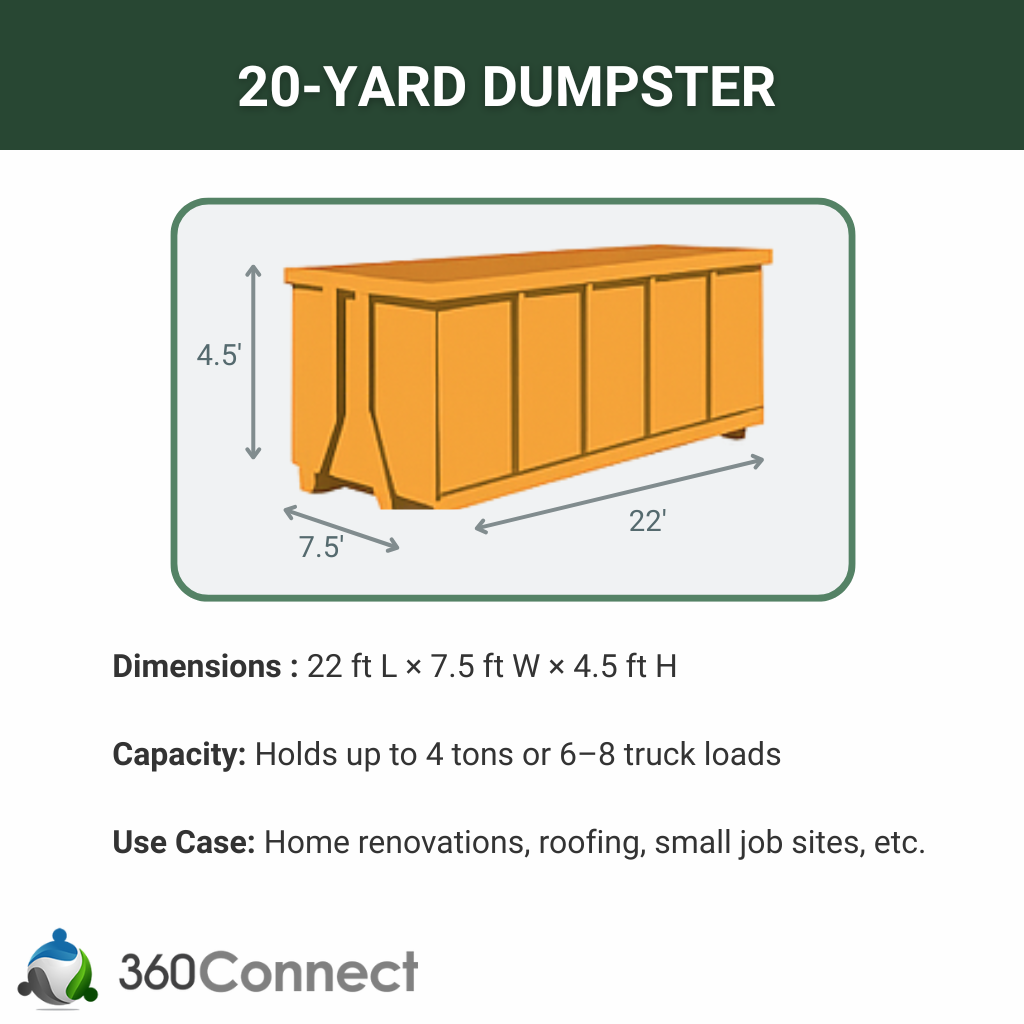
30-Yard Dumpster
Dimensions: 22 ft. long × 7.5 ft. wide × 6 ft. high
Capacity: Holds about 9–10 pickup truck loads
Weight Limit: 3–4 tons
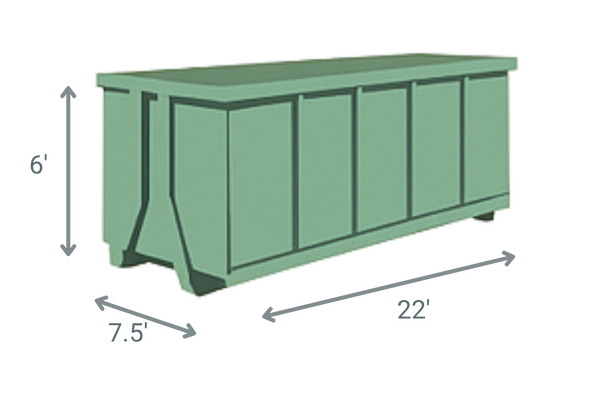
Please note: The exact dimensions, capacity, and weight limit can vary depending on the dumpster rental company.
The 30-yard roll off dumpster is built for larger projects that generate a high volume of waste. It offers more capacity than smaller sizes, making it ideal when you need to handle bulky materials, ongoing debris, or heavier cleanup work without constant hauling. If your project has grown beyond basic cleanout or renovation, this size can keep up.
30-yard roll-off dumpsters are a common choice on construction and demolition job sites, especially for commercial projects, roofing tear-offs, and multi-phase builds. Contractors use 30-yard dumpsters to manage everything from lumber and drywall to concrete, packaging waste, and scrap. With enough space to hold high volumes of material, it’s reliable for active job sites that need consistent, on-site disposal.
On the residential side, 30-yard roll-off dumpsters work well for full home remodels, major downsizing efforts, and estate cleanouts. Whether you’re gutting a house, replacing large fixtures, or removing multiple rooms’ worth of material, the 30-yard dumpster gives you the space to handle it all in one container.
Common Uses of 30-Yard Dumpster
- Construction and demolition job sites
- Commercial property renovations
- Whole-home remodels or additions
- Estate cleanouts or large move-outs
Best for:
Contractors, builders, and homeowners managing large-scale projects with bulky, heavy, or ongoing debris.
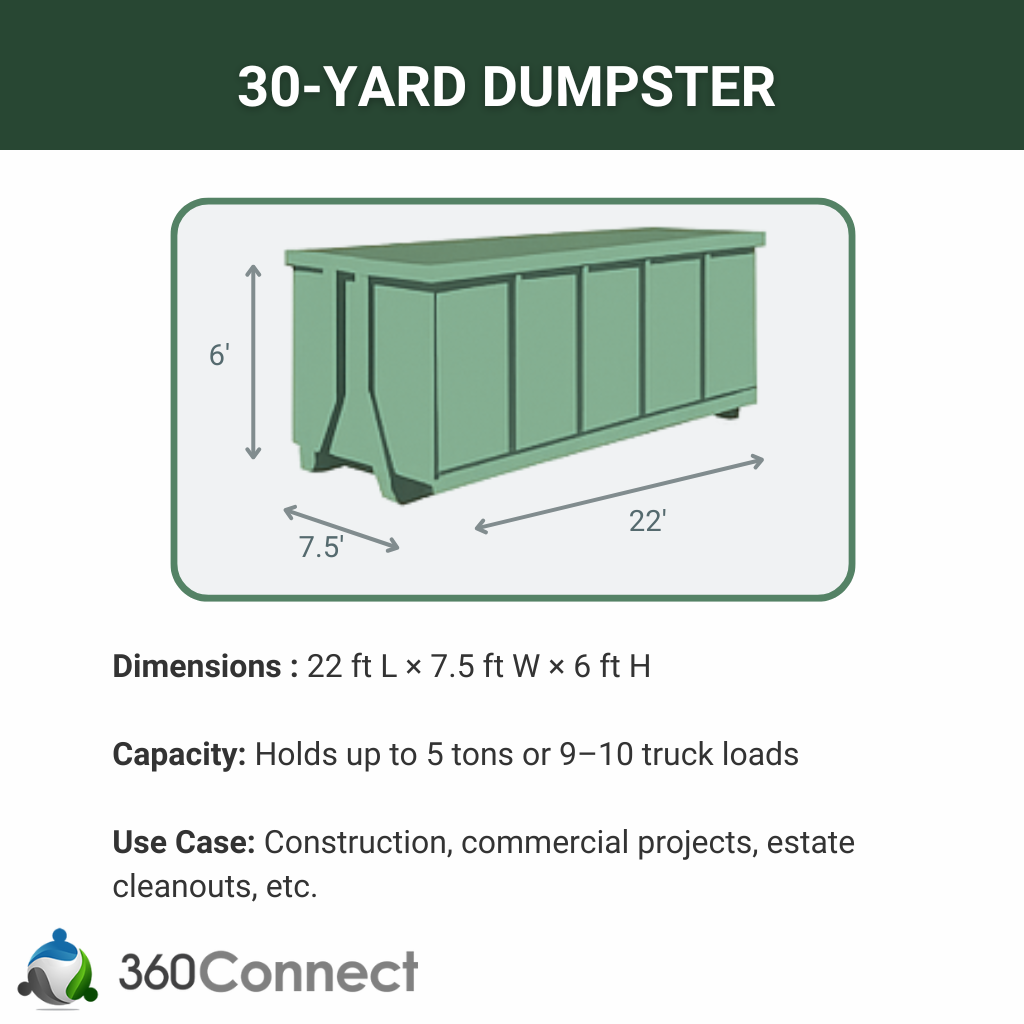
40-Yard Dumpster
Dimensions: 22 ft. long × 8 ft. wide × 8 ft. high
Capacity: Holds about 12–14 pickup truck loads
Weight Limit: 4–6 tons
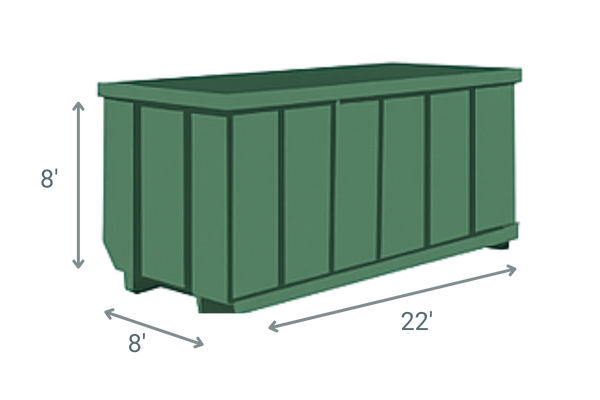
Please note: The exact dimensions, capacity, and weight limit can vary depending on the dumpster rental company.
The 40-yard roll off dumpster is the largest standard size available and is built to handle the most demanding cleanup projects. With the highest capacity of all roll off dumpster sizes, a 40-yard dumpster is designed for serious volume, perfect for projects where bulky materials and nonstop debris are the norm.
40-yard roll-off dumpsters are most commonly used on commercial construction sites, demolition zones, and industrial job sites. Contractors and crews rely on this size to manage large quantities of wood, drywall, concrete, roofing materials, and packaging waste. If you’re running a long-term job that needs consistent on-site disposal, a 40-yard dumpster helps minimize interruptions and keep things moving efficiently.
In addition, 40-yard roll-off dumpsters are used for large-scale residential projects, including full-home demolitions, major storm cleanup, and full-property cleanouts. While it may be overkill for smaller jobs, a 40-yard dumpster gives you the peace of mind that you won’t run out of space.
Common Uses of 40-Yard Dumpster
- Demolition and construction job sites
- Commercial building renovations
- Warehouse and facility cleanouts
- Whole-home demolition or disaster cleanup
Best for:
Contractors, construction teams, and property managers working on high-volume, high-debris job sites that require maximum capacity.
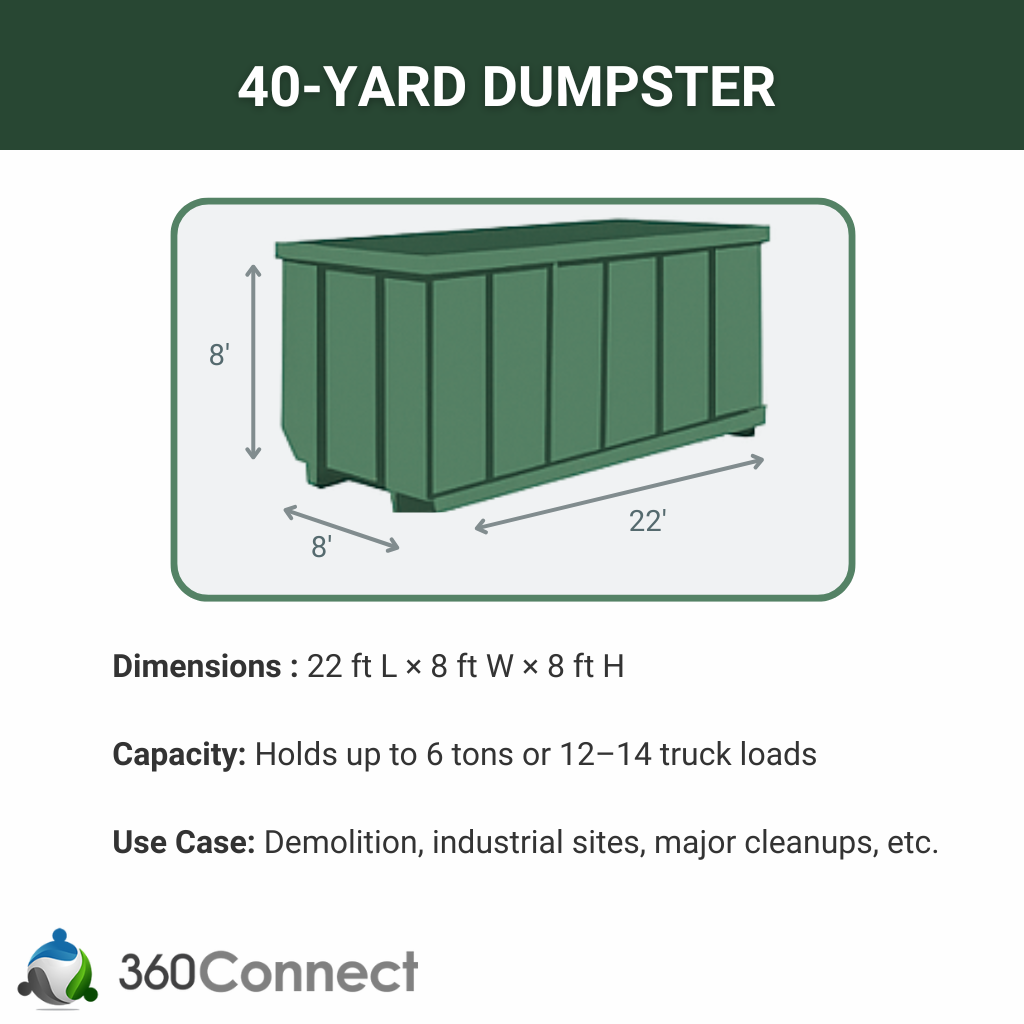
Roll Off Dumpster Size Comparison
Here’s a quick breakdown of the most common roll-off dumpster sizes.
The roll off dumpster comparison chart summarizes everything you need to know about roll off dumpster sizes, including dimensions, estimated capacity, weight limits, and typical uses. So you can easily compare your options at a glance.
| Dumpster Size | Dimensions (L × W × H) | Capacity (Pickup Loads) | Weight Limit | Common Uses |
| 10-Yard | 10′ × 7′ × 4′ | 3–5 | 1–2 tons | Garage cleanouts, small remodels, yard debris |
| 15-Yard | 16′ × 7′ × 4.5′ | 5–6 | 2–3 tons | Flooring removal, multi-room cleanouts |
| 20-Yard | 22′ × 7.5′ × 4.5′ | 6–8 | 2–4 tons | Home renovations, roofing, small job sites |
| 30-Yard | 22′ × 7.5′ × 6′ | 9–10 | 3–4 tons | Construction, commercial projects, estate cleanouts |
| 40-Yard | 22′ × 8′ × 8′ | 12–14 | 4–6 tons | Demolition, industrial sites, major cleanups |
Keep in mind: Dimensions, weight limits, and capacity may vary slightly depending on the roll off dumpster rental provider, so it’s always best to confirm the details before booking.
What Fits in a Roll Off Dumpster?
A roll off dumpster can hold household junk, construction debris, furniture, yard waste, and heavy materials like concrete or roofing shingles, depending on the size you choose.
But what does that mean for each roll off dumpster size? So far, you know the dimensions, the weight limits, and the common use cases of roll off dumpsters, but let’s be honest: you’re probably wondering what actually fits in each dumpster size.
It’s one thing to know a 20-yard dumpster holds “6–8 pickup truck loads.” It’s another to picture that in real life. So let’s break it down. Below, we’ll cover realistic, everyday examples of what each dumpster size can handle, so you can make a confident decision without the guesswork.
What Fits in a 10-Yard Dumpster?
A 10-yard dumpster is best for smaller projects and limited spaces, but it can still hold a surprising amount of material. It’s often used for light cleanups or compact remodeling jobs.
Examples of what fits:
- Flooring or carpet for a single room
- Small furniture like chairs, nightstands, coffee tables
- Yard waste: bagged leaves, branches, dirt
- About 40–60 trash bags
- Boxes and household junk from a garage or attic cleanout
What Fits in a 15-Yard Dumpster?
A 15-yard dumpster gives you a bit more room than a 10-yard dumpster, without taking up a lot of extra space. It’s a solid middle ground for small-to-medium-sized jobs.
Examples of what fits:
- Carpet or flooring from 2–3 rooms
- A kitchen cabinet tear-out
- Light construction debris: drywall, wood, tile
- Cleanout items from a two-bedroom apartment
- Yard debris, fencing, or decking from a small landscaping job
What Fits in a 20-Yard Dumpster?
A 20-yard dumpster is one of the most commonly used sizes because it works for both home and job site projects. It offers enough space for larger debris while still being relatively easy to place.
Examples of what fits:
- Cabinets, countertops, and fixtures from a kitchen or bathroom remodel
- Roofing material from a one-story home
- Furniture: couches, dressers, mattresses
- Debris from a shed or deck removal
- Junk from a whole-house decluttering project
What Fits in a 30-Yard Dumpster?
A 30-yard dumpster is made for bigger projects that generate heavy and bulky waste. It’s frequently used on job sites, construction zones, and full-home renovations.
Examples of what fits:
- Demolition debris: drywall, wood, framing, insulation
- Roofing materials from larger homes or buildings
- Office cleanouts: desks, partitions, shelving
- Large furniture, appliances, and bulky household items
- Debris from estate cleanouts or major move-outs
What Fits in a 40-Yard Dumpster?
The 40-yard dumpster is the largest standard option, built for high-volume, heavy-duty jobs. If you’re dealing with major demolition, commercial construction, or industrial waste, this is the size made to handle it.
Examples of what fits:
- Structural demo waste: brick, concrete, sheetrock
- Large-scale packaging and shipping materials
- Furniture and equipment from commercial spaces
- Warehouse cleanouts or full-building renovations
- Multiple large appliances, mattresses, and oversized items
Roll Off Dumpster Weight Limits
Roll off dumpsters typically hold between 1 to 6 tons of debris, depending on the size. The exact weight limit is determined by your dumpster rental provider and the type of materials you’re disposing of.
So how do you know what that really means for your project? Simple: if you’re tossing lightweight junk, you probably won’t come close to maxing out. But if you’re working with heavier stuff, like concrete, bricks, or roofing shingles, you’ll want to pay close attention to weight limits so you don’t get stuck with surprise overage fees. Here’s a general breakdown of what each dumpster size can typically handle:
- 10-yard dumpster weight limit: 1–2 tons (2,000–4,000 lbs)
- 15-yard dumpster weight limit: 2–3 tons (4,000–6,000 lbs)
- 20-yard dumpster weight limit: 2–3 tons (4,000–6,000 lbs)
- 30-yard dumpster weight limit: 3–4 tons (6,000–8,000 lbs)
- 40-yard dumpster weight limit: 4–6 tons (8,000–12,000 lbs)
Keep in mind: These are averages. Limits vary slightly by provider, so always double-check before placing your order.
How to Choose the Right Roll Off Dumpster Size
Choosing the right roll-off dumpster size comes down to your debris type, project scale, and available space. Pick too small and you risk multiple hauls. Pick too large and you might pay for space you don’t need.
Let’s break it down with a few key questions to help you decide confidently:
1. What kind of debris are you getting rid of?
Start with what you’re tossing. Are you dealing with bulky junk or dense, heavy materials? That’s going to make a huge difference. The type of debris impacts how quickly you hit the dumpster’s capacity or weight limit, even if the container looks half full.
Heavy stuff like concrete, bricks, dirt, or roofing shingles will hit the weight limit before the dumpster is full. Light stuff like furniture, boxes, yard waste, and general junk might fill it to the top without even getting close to the weight cap. And if you’re mixing both types of debris, things can get tricky fast.
Here’s a quick breakdown to help:
- Heavy materials: Think concrete, asphalt, bricks, roofing shingles, or dirt.
- Light materials: Things like cardboard, furniture, clothing, or yard waste.
- Mixed debris: A mix of renovation waste, household junk, and packaging is super common, but can throw off your estimate fast.
If you’re not sure, tell the provider what you’re throwing away. They’ll recommend a size based on experience and help you avoid excess-weight fees.
2. How much stuff do you actually have?
This is where most people guess wrong. Everyone underestimates how much junk or debris they really have, especially when it’s packed into a garage, attic, or demo site. The size of your project will usually give you a good idea of what dumpster size makes sense.
To help you estimate, here’s what each roll-off dumpster size typically holds, in pickup truck load comparisons:
- 10-yard dumpster: 3–5 pickup truck loads
- 15-yard dumpster: 5–7 pickup truck loads
- 20-yard dumpster: 6–8 pickup truck loads
- 30-yard dumpster: 9–10 pickup truck loads
- 40-yard dumpster: 12–14 pickup truck loads
Still unsure? When in doubt, it’s usually better to size up. One larger dumpster is often cheaper than paying for a second haul because your first one filled up too fast.
3. Do you have space on-site?
Before you book anything, take a minute to figure out where your roll-off dumpster is actually going to sit. Not every job site or driveway can handle a 22-foot container. And trust us, you don’t want to be scrambling for space when the truck shows up.
Measure out your available space, look for any low-hanging wires or tree branches, and make sure there’s enough room for the delivery truck to back in, drop the dumpster, and leave without issue. If you’re working in a residential area or tight commercial lot, you may need to go with a smaller size or get a permit for street placement.
Here’s what to think about:
- Driveway length and width: A 20–40 yard dumpster can take up 20+ feet of space.
- Clearance needs: Delivery trucks typically need 60+ feet in a straight line to safely drop the dumpster.
- Street regulations: Some areas require a permit if the dumpster will be placed on the street or public curb.
- Surface protection: If you’re placing it on concrete or asphalt, you might want to lay down boards to prevent damage.
If space is limited, be honest about it when booking. Most rental companies can help you choose a size and placement that works best without creating a headache.
Roll Off DumpsterSpace & Clearance Requirements
To avoid delays or delivery issues, make sure your property has:
- At least 60 feet of length for the delivery truck to access and roll off the dumpster
- A minimum of 10 feet of width
- 20–25 feet of overhead clearance (watch for low-hanging wires or tree branches)
For best results, place the dumpster on a paved or solid surface. Avoid soft dirt or grass that could get damaged.
Choosing the Right Roll Off Dumpster FAQ
The right size depends on the volume and type of debris.
- 10–15 yard: Small cleanouts or light household junk
- 20 yard: Medium renovations such as kitchens or roofing projects
- 30–40 yard: Large home cleanouts, remodels, or construction debris
If you’re in between sizes, it’s usually safer to size up. A 30-yard dumpster gives more flexibility, especially if you uncover more debris mid-project. But if space or budget is tight, a 20-yard dumpster may still do the job for moderate cleanouts or remodels.
It’s usually about 1.5 feet longer and a few inches taller. That might not sound like much, but it could mean the difference between one extra room’s worth of waste or running out of space mid-project.
Not all large dumpsters are suitable for heavy debris like concrete or asphalt. Traditional dumpsters (like commercial front-load bins) usually aren’t built to handle that kind of weight. However, large roll-off dumpsters can be used for heavy materials, as long as you follow weight guidelines. Many providers recommend using a 10-yard roll-off dumpster specifically for dense debris to avoid overage fees or safety issues.
Most providers can swap out your dumpster or schedule a second pickup, but it’ll likely cost extra. Choosing the right size up front helps you avoid delays, overage fees, or added hauls.
Roll Off Dumpster Rental Pricing
Roll off dumpster rental prices typically range from $250 to $700+ per week, and size plays a big role in where your cost lands. Generally, the larger the dumpster, the higher the price.
Here’s a quick look at how roll-off dumpster size affects pricing:
- 10-yard: $250–$400
- 15-yard: $300–$450
- 20-yard: $350–$500
- 30-yard: $450–$600
- 40-yard: $550–$700+
These price ranges are based on averages from reputable dumpster rental providers across the U.S. in addition to Home Advisor. Prices can vary depending on your location, how long you need the dumpster, and what kind of debris you’re getting rid of. These are just ballpark figures to help you plan. Always ask your dumpster rental provider for a full price breakdown, including weight limits, rental period, and any potential overage fees, so there are no surprises.
Final Thoughts on Roll Off Dumpster Sizes
It can be overwhelming to choose the right roll-off dumpster size, especially when you’re already juggling a big upcoming project. But now that you know the dimensions, real-life use cases, and what actually fits inside each size, you’re in a much better spot to make a confident decision.
Whether you’re doing a simple home cleanout or managing a large job site, there’s a roll-off dumpster that fits your needs and your space.
Ready to rent a roll-off dumpster? Start by comparing quotes from trusted providers in your area.
Get Roll Off Dumpster Quotes Today
At 360Connect, we make it easy to get matched with top-rated roll-off dumpster providers in your area. Just tell us a little about your project, and we’ll connect you with up to 5 trusted suppliers based on your location and needs.
Roll Off Dumpster Sizes FAQ
In dumpster sizing, “yard” refers to cubic yards, a measurement of volume.
One cubic yard is 3 feet long by 3 feet wide by 3 feet tall. So, a 20-yard dumpster can hold about 20 of those 3x3x3 cubes of material.
Think of it like this:
- 1 cubic yard = roughly the size of a standard washing machine
- A 10-yard dumpster fits about 10 washing machines’ worth of junk
- A 20-yard fits around 6–8 pickup truck loads
Most standard roll-off dumpsters are around 7.5 to 8 feet wide, regardless of length or height. Always check with your provider, but width usually doesn’t change much between sizes
A 20-yard or larger dumpster can take up most of a residential driveway. You’ll need around 20–25 feet in length and 10 feet in width for the dumpster and delivery truck. Be sure to measure your available space beforehand.
Not always. Availability can depend on your location and the provider’s inventory.
Roll Off Dumpster FAQ
Most roll-off dumpsters can handle furniture, yard waste, construction debris, household junk, small appliances, and roofing materials.
You typically can’t toss tires, paint, chemicals, batteries, refrigerators, air conditioners, or anything hazardous. Always check with your provider. Local landfill rules can vary.
Sometimes, but it may require a permit, depending on your city or HOA rules. Some areas are more lenient, others have restrictions on placement, duration, and traffic flow. Always check with your provider and city to avoid fines.
Roll off dumpsters are one of the most common choices for residential renovation and cleanout projects. In fact, the U.S. generates over 600 million tons of construction and demolition debris each year, according to the EPA, much of which ends up in roll-off dumpsters.

